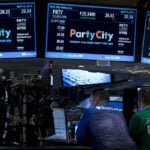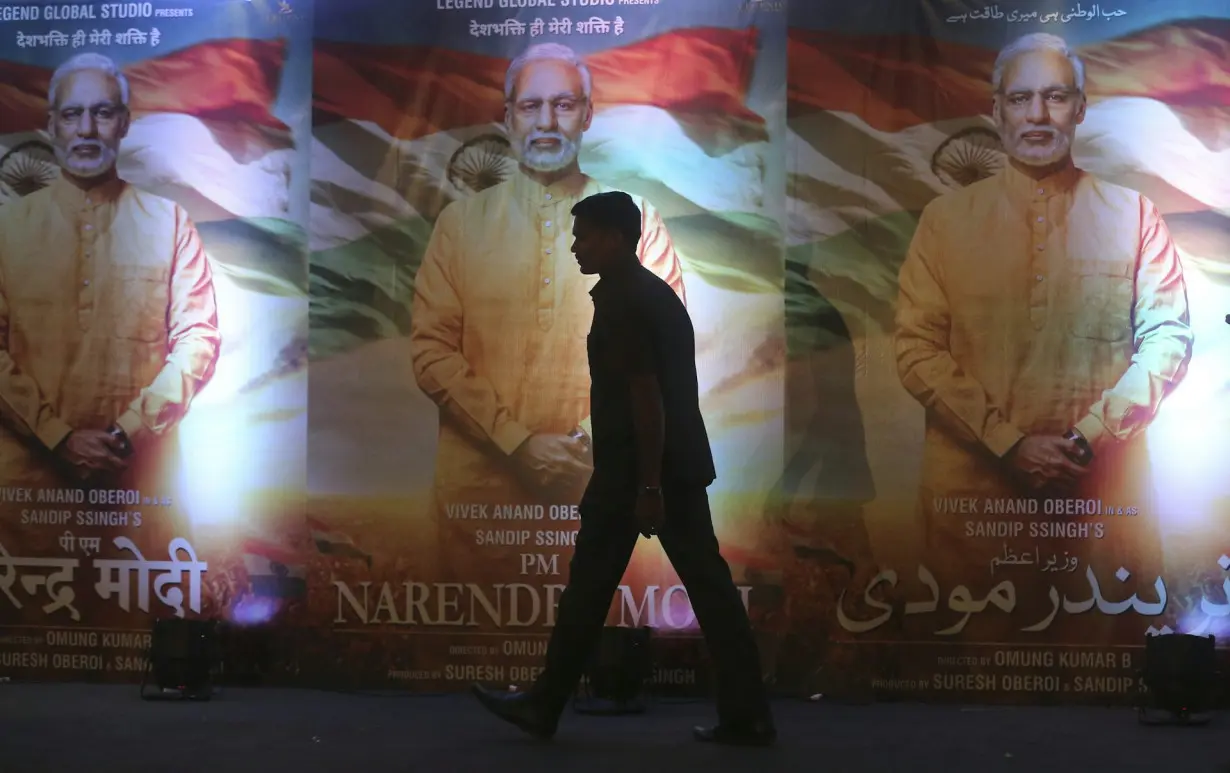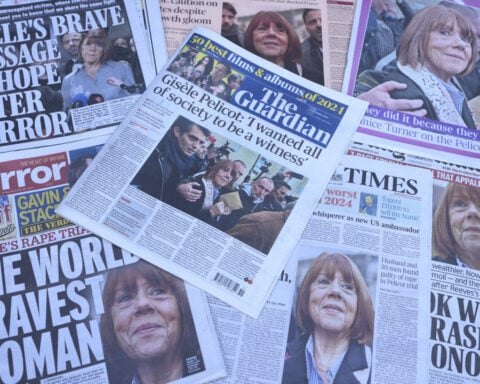As the largest electorate in history goes to the polls in India from April 19 to June 1, 2024, political parties are seeking to influence voters’ decisions – through cinema.
The incumbent Bharatiya Janata Party, or BJP, seeking a third term in office under the leadership of Prime Minister Narendra Modi, has deployed the medium of cinema, more than others, to spread the party’s goals and ideas.
The BJP claims India as a Hindu nation. The Modi government openly supports films that promote the BJP ideology through providing tax breaks and removing regulatory restrictions, especially when such films are strategically timed to release in theaters ahead of the elections. “Swatantrya Veer Savarkar,” a biopic on an ardent advocate of a purely Hindu nation, was released a few weeks before polling begins for the 2024 elections.
India’s entertainment film industry is a complex behemoth with an output of about 1,500 releases per year and a base of fans that extends around the world. Fabulously choreographed dance routines, catchy lyrics, memorable dialogue and historical and religious imagery make it a favored medium of communication – even for political parties.
The use of Indian popular cinema for political ends has a long history – one that predates Indian independence. As an art historian, I documented how cinematic imagery was used to produce a heroic aura around political figures in the south Indian state of Tamil Nadu in my 2009 book “Celluloid Deities: The Visual Culture of Cinema and Politics in South India.”
The connection between cinema and politics made it the primary vehicle for the lengthy careers of numerous charismatic politicians – some of them screenwriters and film producers, others leading actors and actresses. Since the 1980s, it also set in motion a nationwide trend of using cinematic means to capture the attention of voters.
Mobilizing film fans for electoral campaigns
Viewing movies in theaters is an eventful and enjoyable experience that draws a mass audience. As sociologist Lakshmi Srinivas describes in her 2016 book “House Full,” the release of highly anticipated blockbusters is much like a festival. Most striking is the excitement of audiences as they recite the dialogues, dance to the lyrics and hail stars as they appear on the screen.
In an Indian context, cinema’s impact extends from the movie theater to the street in the form of advertisements, fashion and film music that dominate public spaces. Art historian Shalini Kakar argues that the spectacle of cinema brings forth passionate responses from viewing masses that are much like religious emotion. She discusses case studies of film fans who even worship their favorite celebrities as deities by creating temples to these stars within residential and commercial spaces. These fans conduct religious ceremonies and organize public festivities for their favored stars.
But more often, fans are part of a large and vocal collective. Media theorist S.V. Srinivas found that film fans can make or destroy the careers and lives of stars. If a star decides to venture into politics, these film fans can become active participants in the star’s political campaigns. But if the star does something that the fans disapprove of, they will as easily boycott his films and even destroy the star’s career.
An alignment of cinema and politics
The cinema industry in Tamil Nadu, more than any other in India, has evolved closely with political and social developments in the region since the 1940s. The ideals of Tamil nationalism, a political movement that changed the course of history in Tamil Nadu, were powerfully communicated through the medium of entertainment films. Often, the personalities associated with these films were physically present alongside politicians at party meetings.

In my research, I found that the alignment of cinema and politics in Tamil Nadu was helped by the use of identical advertising media. Political parties regularly commissioned advertisers to produce “star images” of politicians. A favored publicity medium of both the cinema industry and party members was the hand-painted plywood cutout. These full-length portraits, 20 feet to 100 feet in height, featured charismatic leaders of Tamil nationalist parties such as M. Karunanidhi, a prolific and influential scriptwriter, and J. Jayalalithaa, a famous film star turned politician.
Though these political portraits were meant to be realistic rather than melodramatic, the style and scale of these portraits resembled the cinematic star image. In this way, they helped to transfer the power of the cinematic star image to the image of the leader.
I argued that these advertisements played an important role in visualizing, and shaping, the identity politics of Tamil nationalism.
The audience for these images numbered in the millions. When these vibrantly colored portraits of film stars and political leaders appeared side by side in public spaces, they soared above the skyline like celestial beings. Often, the images became the focus of adulation. They were feted and garlanded, people danced, burst crackers, cheered and crowded around these images, and posed next to them for photographs.
The charismatic politicians of the Tamil nationalist movement set the trend of combining the sheen of the star image, the power of political portraiture and the divine aura of icons in their advertising.
Cinema’s role in divisive politics
Under Modi’s leadership, three themes emerge in a cluster of films that favor the BJP’s goals and policies and are endorsed by the party: claiming credit for welfare initiatives, instilling Hindu nationalist beliefs in society, and heightening tensions between the Hindu majority and Muslim minority communities.
For example, a film released in 2017, “Toilet: Ek Prem ki Katha,” or “Toilet: A Love Story,” tells the story of a couple whose marriage starts to fall apart over the lack of a toilet within the home. At the beginning of the film, which is an entertaining musical melodrama, viewers are informed that while Mahatma Gandhi championed for a clean environment, it is Modi who is making that dream a reality through budgeting for the construction of toilets nationwide.
Another series of films in the biopic genre showcases the historical legacy of right-wing Hindu nationalist organizations and their leaders. “PM Narendra Modi,” which reminded voters of the prime minister’s rise from poverty, was scheduled for release just before the 2019 elections. But the Election Commission of India, an independent body charged with ensuring free and fair elections, ordered that the film could be released only after the elections.
A third and more troubling genre is politically polarizing films. Drawing on ethnically charged actual events in which communities of Hindus and Muslims clashed, the scripts for these films dramatize highly biased narratives in which Hindus are cast as the victims while Muslims are the villainous perpetrators.
Widely viewed examples of this genre include “Kashmir Files,” which shows the mass exodus of Hindus from the north Indian state of Kashmir in the early 1990s when they were targeted by a pro-Pakistan armed uprising of Kashmiri Muslims. The film, which demonizes Muslims and shows them committing extremely barbaric and cruel acts, is among those publicly endorsed by the prime minister himself.
Film producers and distributors I interviewed for my research were unanimous that it was impossible to accurately predict whether a film would succeed at the box office, as are the results of the elections.
Should the BJP succeed, however, it would be fair to conclude that one element in the hat trick was a clever endorsement of cinema as a vehicle for party propaganda.

Preminda Jacob does not work for, consult, own shares in or receive funding from any company or organization that would benefit from this article, and has disclosed no relevant affiliations beyond their academic appointment.
Source: The Conversation

 German Christmas market ramming is the latest attack to use vehicles as deadly weapons
German Christmas market ramming is the latest attack to use vehicles as deadly weapons
 How to save a fentanyl victim: Key facts about naloxone
How to save a fentanyl victim: Key facts about naloxone
 Eight convicted in France over murder of teacher who showed Prophet caricature
Eight convicted in France over murder of teacher who showed Prophet caricature
 In a calendar rarity, Hanukkah starts this year on Christmas Day
In a calendar rarity, Hanukkah starts this year on Christmas Day
 What to know about Hanukkah and how it's celebrated around the world
What to know about Hanukkah and how it's celebrated around the world
 Russia's UK embassy denounces G7 loans to Ukraine as 'fraudulent scheme'
Russia's UK embassy denounces G7 loans to Ukraine as 'fraudulent scheme'
 Retailer Party City files for bankruptcy, will wind down 700 stores
Retailer Party City files for bankruptcy, will wind down 700 stores
 Philadelphia 76ers star Joel Embiid working through injuries and mental health struggles
Philadelphia 76ers star Joel Embiid working through injuries and mental health struggles
 Weightlifting Taiwan granny, 90, garners cheers, health benefits at gym
Weightlifting Taiwan granny, 90, garners cheers, health benefits at gym
 Soccer's top players have had enough, as FIFA's new super-sized tournament sparks a revolt
Soccer's top players have had enough, as FIFA's new super-sized tournament sparks a revolt
 A man walks past posters of the film 'PM Narendra Modi,' a biopic on the Indian prime minister, during its launch in Mumbai, India, in 2019.
A man walks past posters of the film 'PM Narendra Modi,' a biopic on the Indian prime minister, during its launch in Mumbai, India, in 2019.







